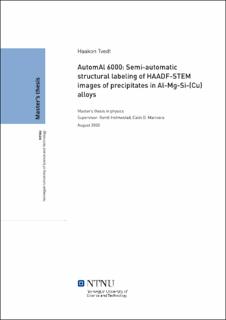| dc.contributor.advisor | Homestad, Randi | |
| dc.contributor.advisor | Marioara, Calin Daniel | |
| dc.contributor.author | Tvedt, Haakon | |
| dc.date.accessioned | 2021-09-28T18:39:13Z | |
| dc.date.available | 2021-09-28T18:39:13Z | |
| dc.date.issued | 2020 | |
| dc.identifier | no.ntnu:inspera:57076746:31398369 | |
| dc.identifier.uri | https://hdl.handle.net/11250/2785562 | |
| dc.description.abstract | Når Al-Mg-Si (6xxx) legeringer utherdes, får vi en rik samling av utfellinger eller presipitater, de fleste som nåler, stenger eller staver langs <100> retningene i aluminiumsgitteret. Disse presipitatene har betydelig innflytelse på materialets egenskaper, som for eksempel duktilitet og styrke, og det foregår mye forskning for bedre å forstå utfellingssekvensen til legeringer under utherding. Atomstrukturen i flere av fasene som dukker opp som presipitater i dette systemet kan beskrives som atomkolonner av legeringselementer (Mg, Si og Cu) med periodisitet langs <100> Al. Det har vist seg at disse kolonnene i 6xxx-systemet som oftest er karakterisert av et sett med enkle strukturelle prinsipper eller regler, som gjør det mulig å identifisere atomslag og den relative forskyvningen (langsgående hopp) av atomkolonnene som omfatter hele tverrsnittstrukturen på nålene. Med noen unntak har disse reglene vist seg å være nyttige, ikke bare for å analysere fasene i dette systemet, men også for å karakterisere uordnede presipitater, grenseflater og hybride utfellinger som inneholder flere faser.
Moderne forskning innen nanoskala materialvitenskap er utstyrt med stadig mer sofistikerte verktøy og teknikker, hvor atomoppløsnings-aberrasjonskorrigert høyvinkel angulær mørkfelt-skanning transmisjonselektronmikroskopi (HAADF-STEM) spiller en viktig rolle. Med målet om å analysere slike HAADF-STEM-bilder av presipitattverrsnitt i Al-Mg-Si- (Cu) -systemet, har vi utviklet den frittstående programvaren AutomAl 6000.
AutomAl 6000 har blant annet en metode for kolonnedeteksjon, en algoritme basert på symbiosen til en statistisk modell og reglene som er formulert i et digraflignende rammeverk, samt et grafisk brukergrensesnitt. Fra et 2D-projisert HAADF-STEM-bilde av et tverrsnitt til et presipitat, kan programvaren semi-autonomt bestemme 3D-kolonneposisjoner og atomslag hvor reglene gjelder. I sin tur kan AutomAl 6000 deretter brukes til å vise atomoverlegg av utfellingen, analysere eller vise forskjellige andre representasjoner av dataene. Linker til programmet, så vel som andre ressurser, finnes på http://automal.org. | |
| dc.description.abstract | The 6xxx Al alloy series, when subject to age hardening, can present a rich collection of precipitate structures, most extending as needles, laths or rods along the <100> directions in the aluminium matrix. These precipitates significantly influence properties of the bulk material, most notably ductility and strength, and are therefore the objective of extensive research aimed at better understanding the precipitation sequence of alloys during aging. The atomic structures of the majority of the phases that appear in this system, can be described as bundles of atomic columns following the matrix periodicity along <100> Al, where most are hijacked by the solute elements. It has been found that the columns in the 6xxx system precipitates are commonly characterized by a set of simple structural principles or rules, that allow identification of the species and the relative displacement (longitudinal jumps) of the atomic columns that comprise the entire cross-section structure of the needles. With some exceptions, these rules have proved to be useful for not only analyzing the phases in this system, but also to characterize disordered precipitates, matrix/precipitate interfaces, and hybrid precipitates containing multiple phases.
Modern research in the field of nano-scale material science is equipped with increasingly sensitive tools and techniques, of which atomic resolution aberration-corrected high-angle annular dark field scanning transmission electron microscopy (HAADF-STEM) plays an important part. With the goal of analyzing such HAADF-STEM images of particle cross-sections in the Al-Mg-Si-(Cu) system, we have developed the stand-alone software AutomAl 6000.
AutomAl 6000 features, amongst other, a method for column detection, an algorithm based on the symbiosis of a statistical model and the rules formulated in a digraph-like framework, as well as an approachable graphical user interface. From a 2D projected HAADF-STEM image of a cross-section precipitate, the software can semi-autonomously determine the 3D column positions and column species wherever the rules are applicable. In turn, AutomAl 6000 can then be used to display atomic overlays of the precipitates, analyze or display various other representations of the data. Links to the active repository, as well as other resources can be found at http://automal.org. | |
| dc.language | | |
| dc.publisher | NTNU | |
| dc.title | AutomAl 6000: Semi-automatic structural labeling of HAADF-STEM images of precipitates in Al-Mg-Si-(Cu) alloys | |
| dc.type | Master thesis | |
